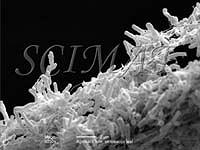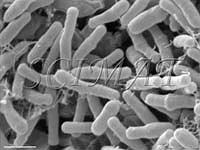 |
 |
| A. tumefaciens bacteria on a tobacco leaf Bar: 2 Ám |
A. tumefaciens bacteria on a bacterial filter Bar: 1 Ám |
 |
 |
| A. tumefaciens bacteria on a tobacco leaf Bar: 2 Ám |
A. tumefaciens bacteria on a bacterial filter Bar: 1 Ám |
|
Agrobacterium tumefaciens (new name: Rhizobium radiobacter) is a soil bacterium which infects almost 10,000 species of plants, including fruit trees of the rose family (apples, cherries, pears, etc.) causing what is known as crown gall disease. While the disease is harmful to some plants, it is not usually considered a major threat to crops. It has attracted the attention of agricultural scientists at universities and government laboratories, particularly becauase it may serve as a model for the development of tumours. Recently it has been found as a potential pathogen in humans. When Rhizobium radiobacter infects a plant, it injects a circular piece of a DNA plasmid into plant cells. Apart from causing a kind of plant cancer, it is being used in genetic manipulation, to carry foreign genes into plant cells. Galls may develop anywhere on stems and roots, but are usually found near the soil line, because the bacterium attacks plants at the junction between the root and shoot at the soil surface. The galls vary from pea size up to several inches in diameter. Unlike insect galls, crown galls are a solid mass of tissue all the way through. R. radiobacter (Agrobacterium) causes the plant to form galls (tumours) on the crown by transferring a piece of DNA from the bacterium to the plant. It contains the Ti plasmid with the ability to enter plant cells and insert a portion of a genome into plant chromosomes. In this way, the bacterium is a useful tool making it possible to genetically modify a plant by inserting various genes including even those which do not occur in plants to produce transgenic plants. There are several electron microscopy images of the bacterium on the Internet including this one, another, and another. Agrobacterium Protocols is a book on methods in molecular biology. SEM by the author. |
©SCIMAT 2011 |